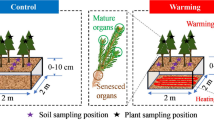Abstract
The literature concerning the extraction and quantification of juglone (5-hydroxy-1,4-naphthoquinone) frequently fails to differentiate between juglone and its immediate precursors. The proposal that the term “juglone potential” be used to define the total concentration of juglone under an oxidative environment in walnut tissues is made. The juglone potential of a given tissue will more accurately reflect the allelopathic agent's presence than will juglone concentration of the tissue alone. The term juglone potential accepts the multiple chemical nature of juglone found in walnut tissue and gives a precise way for quantification of allelopathic action. The objective of this study was to measure seasonal changes in black walnut juglone potentials at various locations in the crown. Juglone potentials were measured weekly in leaves at the top, middle, and bottom of the tree crowns. The results showed a linear decrease in juglone potential over the growing season. The results also showed no significant difference in leaf juglone potentials among the three crown positions. If reanalyzed without the middle crown position juglone potentials were significantly greater in the lower crown positions when compared with the higher crown position. Potential use of juglone to manipulate species composition and decrease interference in plant communities is discussed.
Similar content being viewed by others
References
Brooks, M.G. 1951. Effect of black walnut trees and their products on other vegetation. West Virginia Agricultural Experiment Station Bulletin 347, 31 pp.
Daglish, C. 1950a. The isolation and identification of a hydrojuglone glycoside occurring in the walnut.Biochem. J. 47:452–457.
Daglish, C. 1950b. The determination and occurrence of a hydrojuglone glucoside in the walnut.Biochem. J. 47:458–462.
Davis, E.F. 1928. The toxic principle ofJuglans nigra as identified with synthetic juglone, and its toxic effects on tomato and alfalfa plants.Am. J. Bot. 15:62 (abstract).
Gries, G.A. 1943. Juglone—the active agent in walnut toxicity.Proc. North. Nut Growers Assoc. 34:52–55.
Hedin, P.A., Langhans, V.E., andGraves, C.H. 1979. Identification of juglone in pecan as possible factor of resistance toFusicladium effusum.J. Agric. Food Chem. 27(1):92–94.
Hedin, P.A., Collum, D.H., Lanhans, V.E., andGraves, C.H. 1980. Distribution of juglone and related compounds in pecan and their effect onFusicladium effusum.J. Agric. Food Chem. 28:340–342.
Hoy, P.R., andStickney, J.S. 1881. Comments on walnut.Trans. Wisc. State Hortic. Soc. 11:166–167.
Khan, M.S. 1966. Possible mycorrhizal associates of black walnut. Unpublished master's thesis. Library, Iowa State University, Ames, Iowa, 90 pp.
Koppe, D.E. 1972. Some reactions of isolated corn mitochondria influenced by juglone.Physiol. Plant 27:89–94.
Langhans, V.E., Hedin, P.A. andGraves, C.H. 1978. Fungitoxic chemicals in pecan tissue.Plant Dis. Rep. 62(10):894–898.
Massey, A.B. 1925. Antagonism of the walnuts (Juglans nigra L. andJuglans cinera L.) in certain plant associations.Phytopathology 15:773–784.
Muller, W.U., andLeistner, E. 1976. 1,4-Naphthoquinone, an intermediate in juglone biosynthesis.Phytochemistry 15:407–410.
Muller, W.U., andLeistner, E. 1978. Metabolic relation between naphthalene derivatives inJuglans.Phytochemistry 17:1735–1738.
Pardhasaradhi, M., andHari Babu, M. 1978. A new bisjuglone fromJuglans nigra root bark.Phytochemistry 17:2042–2043.
Perry, S.F. 1967. Inhibition of respiration by juglone inPhaseolus andLycopersicon.Bull, Torrey Bot. Club 94(1):26–30.
Rice, E.L. 1974. Allelopathy. Academic Press, New York, 353 pp.
Rice, E.L. 1979. Allelopathy—an update.Bot. Rev. 45(1):15–109.
Steel, R.G.D., andTorrie, J.H. 1980. Principles and Procedures of Statistics, 2nd ed. McGraw-Hill New York, 633 pp.
Author information
Authors and Affiliations
Additional information
Journal Paper No. J-10747 of the Iowa Agriculture and Home Economics Experiment Station, Ames, Iowa. Project No. 2172.
Rights and permissions
About this article
Cite this article
Coder, K.D. Seasonal changes of juglone potential in leaves of black walnut (Juglans nigra L.). J Chem Ecol 9, 1203–1212 (1983). https://doi.org/10.1007/BF00982222
Received:
Revised:
Issue Date:
DOI: https://doi.org/10.1007/BF00982222




